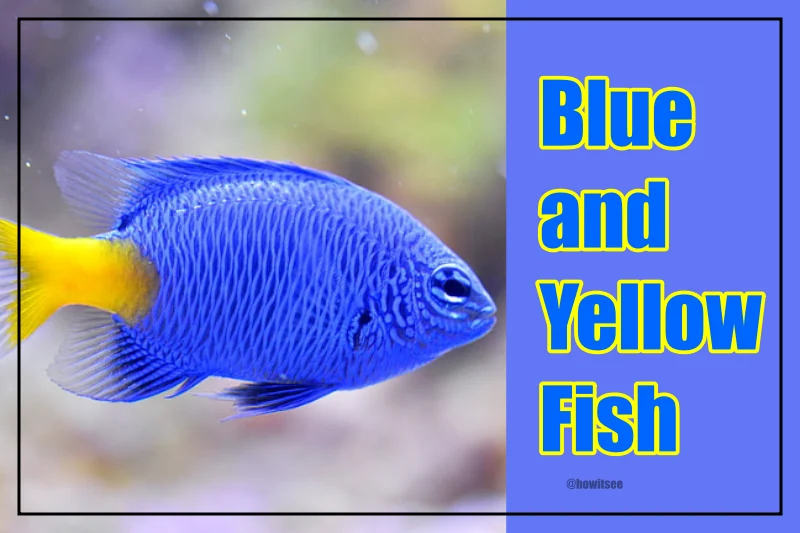This world is full of colors and nature has some of the most significant organisms with the most magnificent colors. When we think of the mesmerizing world beneath the waves, one can’t help but imagine the vibrant colors that inhabit it.
Among the most captivating marine creatures are the blue and yellow fish, adorned with their stunning hues that create a spectacle of beauty in the underwater realm. Here is the list of 20 such blue and yellow fish which ensure the beauty of their water habitat be it an ocean, sea, or pond.
20 Blue and Yellow Fish
1) Yellowtail Blue Damsel
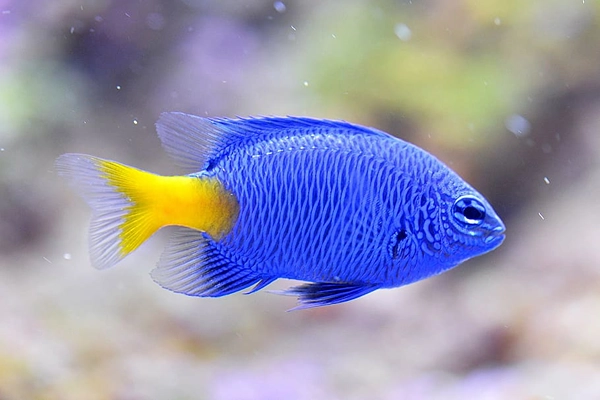
| Scientific Name | Chrysiptera parasema |
| Size | 3 inches |
| Location | Red sea and Hawaii |
| Diet | Algae and tiny invertebrates. |
There are around 300 varieties of damselfish, but one of them is blue and yellow. This may be found in Indo-Pacific seas, including the Red Sea and Hawaii.
These fish like swimming around shallow coral reefs. They are known to be violent and possessive. These fishes like swimming in groups as a school. They may be found in depths of around 3 feet (1 metre) but are also abundant in deeper places.
The usual blue and yellow damselfish length is around 3 inches (7-8 centimetres). Their blue body with yellow fins and tail makes them simple to spot. When it’s time to eat, they go in search of algae and tiny invertebrates.
3) Palenose Parrotfish
| Scientific Name | Scarus psittacus |
| Size | 24 inches |
| Location | The Indian and Pacific Oceans, the Red Sea, Persian Gulf and Gulf of Aden to Sodwana Bay, it ranges eastwards across the Indian Ocean and into the Pacific Ocean extending eastwards to Hawaii, north to southern Japan and south to Australia |
| Diet | algae-covered coral |
They can be found in the western Atlantic Ocean, such as in Florida or the Bahamas. The Caribbean Sea and the Gulf of Mexico (both of which are part of the western Atlantic Ocean) are also part of their territory.
These fish like shallow coral reefs where they may graze on algae. They can, however, be found in deeper places depending on the locality. A parrotfish nibbles on algae-covered coral.
These fish are frequently found in tiny groups or even alone. Blue and yellow parrotfish may reach lengths of up to 16 inches (40 centimetres). However, the bigger ones can measure up to 24 inches (60 centimetres) in length.
4) Blue Tang
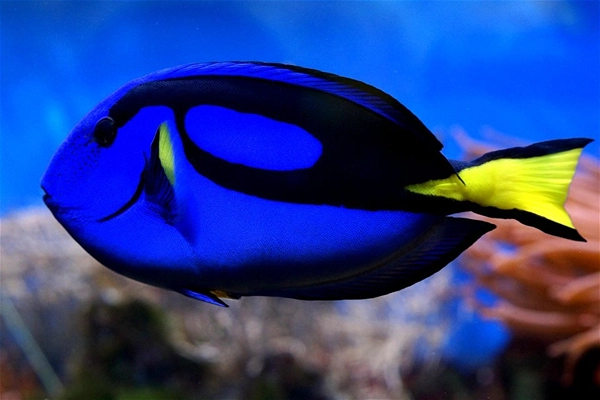
| Scientific Name | Paracanthurus hepatus |
| Size | 12 inches |
| Location | Reef of Philippines, Indonesia, Japan and the Great Barrier Reef of Australia. |
| Diet | Planktons and Algae |
Blue tang scientifically known as Paracanthurus hepatus is a bright blue fish with a yellow tail found across Philippines Indonesia and Japan.
They eat planktons and Algae as their food. These fish are pretty active and able to swim quite a distance. That’s how they collect a good amount of food.
Blue and yellow tang often swim in small groups. They grow up to about 12 inches in length, even though some can be bigger. Males are usually larger than the female blue tang It’s easy to identify these fish with their blue body and yellow tail.
5) Blue Jaw Triggerfish
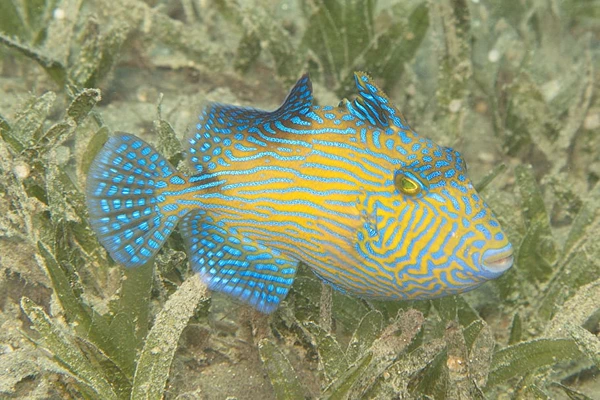
| Scientific Name | Xanthichthys auromarginatus |
| Size | 10-12 inches |
| Location | Indo Pacific Oceans, usually from East Africa to Hawaii Islands. |
| Diet | a varied diet of meaty foods including; squid, krill, clams, small fish and hard shelled shrimp to help wear down their ever growing teeth |
The blue and yellow triggerfish scientifically known as Xanthichthys auromarginatus is also called “Blue Jaw Triggerfish” and is a member of the Balistidae family. They normally swim alone or in couples and can reach a length of 10 to 12 inches.
This fish is completely coated in (light) blue. This fish is easily identified by the bright yellow stripes surrounding its dorsal fins and tail. Blue and yellow triggerfish prefer to eat a variety of food as their diet.
6) Blue and Yellow Snapper (Bluestripe Snapper)

| Scientific Name | Lutjanus kasmira |
| Size | 14 inches |
| Location | Australia, Indonesia, and the Maldives |
| Diet | small fish and invertebrates. |
These fish, often known as bluestripe snapper and officially identified as Lutjanus kasmira, are members of the Lutjanidae family. They are widespread in the Indo-Pacific area (particularly in Australia, Indonesia, and the Maldives).
Bluestripe snappers prefer shallow coral reefs and rock structures of various kinds. They can, however, be found in deeper locations as well. They are simple to spot since they frequently swim in huge groups.
Although their normal length is approximately 10 inches (25 centimetres), these fish may grow up to 14 inches (35 centimetres) in length. Their yellow body and tail are complemented by four blue horizontal lines. Bluestripe snappers feed small fish and invertebrates.
7) Yellow and Blueback Fusilier
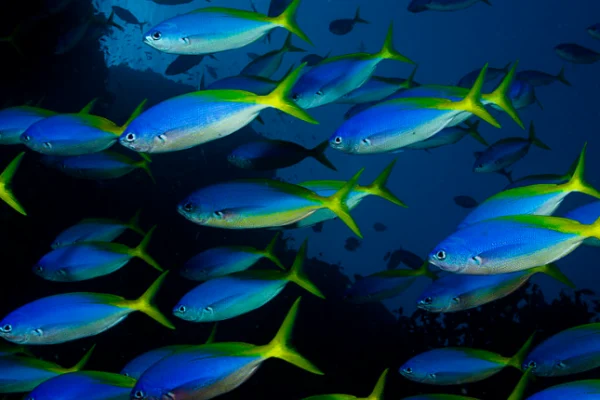
| Scientific Name | Caesio teres |
| Size | Upto 40 cm |
| Location | Eastern Africa, Indonesia, or Hawaii |
| Diet | zooplankton, tiny animals |
The Caesionidae family includes the blue and yellow fusilier (Caesio teres). They may be found throughout the Indian Ocean, as well as the western and central Pacific Oceans.
Although they may be found in deeper waters, these fish prefer to swim and graze in shallow water. They normally stay near to coral reefs, between 3 and 5 feet deep. They are, nonetheless, widespread in deeper places, up to 200 feet in depth.
Fusilier fish, both blue and yellow, love to swim in groups. But, they may be identified by their gleaming blue body and golden tail.
8) Lemonpeel Angelfish
| Scientific Name | Centropyge flavissimus |
| Size | 4 inches |
| Location | Hawaii, the Maldives, or Australia’s Great Barrier Reef. |
| Diet | Algae |
The Pomacanthidae family also includes Lemon peel angelfish (Centropyge flavissimus). They may be found in the Pacific and Indian Oceans.
These fish like shallow and deeper reefs. Lemonpeel angelfish might be difficult to see when compared to other blue and yellow fish species.
They frequently hide in rocky regions. Lemonpeel angelfish may reach a length of around 4 inches (10 centimetres) and basically, yellow is their dominant colour.
9) Blue and Yellow Peacock Cichlid
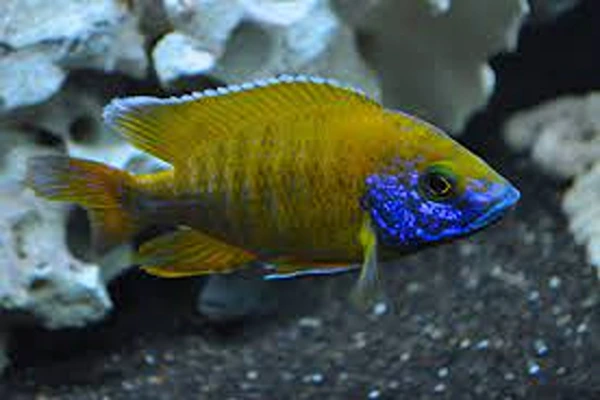
| Scientific Name | Aulonocara baenschi |
| Size | 6 inches |
| Location | Lake Malawi in east Africa |
| Diet | worms and beetles |
The Cichlidae family includes the blue and yellow peacock cichlid (Aulonocara baenschi). Lake Malawi in east Africa is its primary home.
Peacock cichlids are freshwater fish that frequently swim around underwater rock formations. They may reach a height of 6 inches (15 centimetres) and dwell in clusters. They are territorial, so keep a safe space between you and them.
Their blue and yellow colour schemes might differ. To put it another way, some may have more blue patches than others. Besides, algae and tiny invertebrates like worms and beetles are among their favourite foods.
10) Blue and Yellow Fairy Basslet
| Scientific Name | Gramma loreto |
| Size | 3 inches |
| Location | Caribbean Sea |
| Diet | Small crabs and Invertebrates |
The Grammatidae family includes the blue and yellow fairy basslet (Gramma loreto). These fish can be seen by snorkelers in the Caribbean Sea.
The best places to watch them are on the island of Curacao, however, they appear to love the seas of Bonaire as well.
These fish are like shallow water near coral reefs. They are timid and frequently try to conceal themselves. They can grow to be 3 inches (7-8 centimeters) long.
These fish have a blue head and a yellow tail. Small crabs and invertebrates are among their favorite foods.
11) Yellow Bar Angelfish
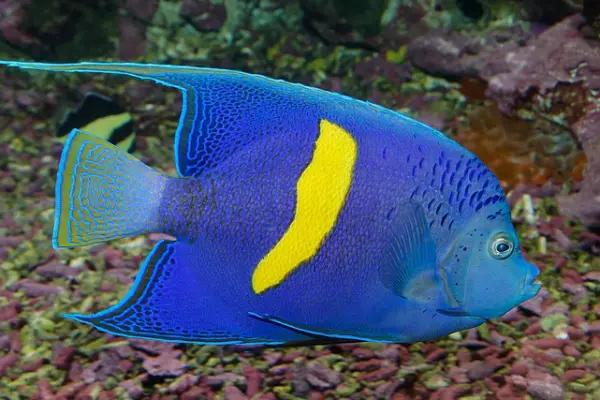
| Scientific Name | Pomacanthus maculosus |
| Size | Upto 50 cm |
| Location | Eastern Mediterranean Sea and the western Indian Ocean |
| Diet | spirulina and other algae |
Pomacanthus maculosus, also known as the yellow bar angelfish, half-moon angelfish, yellow-marked angelfish, yellow band angelfish, or yellow-blotched angelfish, is a ray-finned fish found in the sea.
It has lately been discovered in the eastern Mediterranean Sea and the western Indian Ocean. Filaments extend back from the soft-rayed sections of the dorsal and anal fins, past the caudal fin, in adults.
Adults have a brownish blue background with a blue margin around each scale, giving the impression that it is mainly blue. However, an uneven yellow come runs across the center of the flanks, with dark blue, vertically elongated areas towards the head.
12) Powder Blue Tang
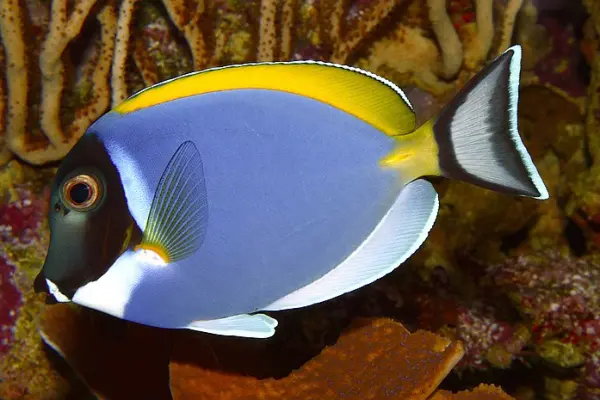
| Scientific Name | Acanthurus leucosternon |
| Size | 9 inches |
| Location | Indian Ocean to western Pacific Ocean |
| Diet | Algae |
The fish can grow to be 23 cm (9 in) long on average. The body is oval in form and laterally compressed. Acanthurus leucosternon, like other surgeonfishes, swims with its pectoral fins.
The caudal fin is shaped like a crescent. The fish has a “surgeon’s scalpel,” which is an expanded section of the spine at the base of the tail. The mouth is short and pointed in a beak-like fashion, with tiny and sharp teeth for taking food in tight spaces.
Its sides are blue; its dorsal fin and caudal fin base are yellow; its head is black; and its mouth, throat area, anal and pelvic fins are white. Also, the transparent pectoral fins have yellow reflections.
13) Asfur Angelfish
| Scientific Name | Pomacanthus asfur |
| Size | Upto 16 inches |
| Location | Western Indian Ocean |
| Diet | Sponge and tunicates |
As a youngster, Pomacanthus asfur has a completely different color and pattern than the adult. Juveniles have a blue body that is striped with pale blue and white. Their dorsal and caudal fins grow golden markings as they mature.
They have an overall dark blue body with a blackish face, a yellow caudal fin, and a broad crescent-shaped yellow band running vertically across the flanks until they are fully developed adults.
Sponge and tunicates dominate their diet. Mostly, it is a solitary and reclusive fish that divers find difficult to approach, and it is most commonly found around caves or cracks in the reef.
14) Queen Angelfish
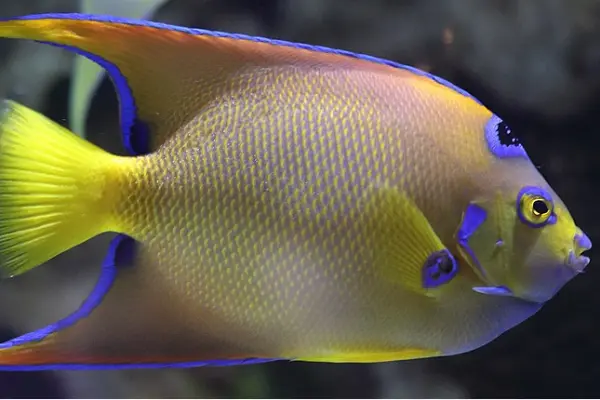
| Scientific Name | Holancanthus ciliaris |
| Size | Upto 18 inches |
| Location | Atlantic Ocean |
| Diet | Plankton and Algae |
The queen angelfish Scientifically known as Holacanthus ciliaris is a species of marine angelfish found in the western Atlantic Ocean. It is also known as blue angelfish, golden angelfish, or yellow angelfish.
It is an ocean-bottom living species that live in coral reefs. The body of the queen angelfish is large, flattened, and oval-shaped, with a small mouth filled with bristle-like teeth. This crown is the primary feature that distinguishes the species from the Bermuda blue angelfish.
But the juveniles are dark blue with vertical brilliant blue stripes and a yellow chest region. They are similar to young blue angelfish but have more folded vertical stripes.
15) Emperor Angelfish
| Scientific Name | Pomacanthus imperator |
| Size | Upto 15 inches |
| Location | Red Sea to Hawaii and Austral Islands |
| Diet | Small invertebrates and plants |
The emperor angelfish (Pomacanthus imperator) is a marine angelfish species. It is a reef fish native to the Indian and Pacific Oceans, ranging from the Red Sea to Hawaii and the Austral Islands.
This species typically occurs with stable populations and suffers no significant extinction concerns. It is a favorite among photographers, artists, and aquarists due to its distinct, vivid color pattern.
The adults have blue and yellow horizontal stripes on their backs, a light blue face with a dark blue mask over their eyes, and a yellow caudal fin.
Moreover, the apex of a blackish stripe above the pectoral fins is at the level of the upper orbit. This band’s front and back margins are both vivid blue.
16) Reef-dwelling Blue and Yellow Grouper

| Scientific Name | Epinephelus flavocaeruleus |
| Size | Upto 90 cm |
| Location | Gulf of Aden down to Port Alfred in South Africa and eastward to Sumatra, Indonesia |
| Diet | Fishes, crabs, shrimps, spiny lobsters, squids, and small octopi |
Epinephelus flavocaeruleus, also known as blue-and-yellow grouper, is a species of ray-finned fish from the subfamily Epinephelinae, which is part of the Serranidae family, which also contains anthias and sea basses.
It is linked to reefs in the Indian Ocean. The head and body are dark bluish violet to dark greyish blue, with pale blue flecks here and there, while the fins and jaws are bright yellow.
The corners of the caudal fin, the border of the soft-rayed area of the dorsal and anal fins, and the tips of the pelvic fins are all blackish in some fish.
Also, as the fish grows older, the yellow color fades, and the larger adults are usually dark gray, dark blue, purple, reddish brown, or practically black.
17) Blue Ring Angelfish
| Scientific Name | Pomacanthus annularis |
| Size | Upto 18 inches |
| Location | Indo-West Pacific oceans from East Africa, throughout Indonesia and New Guinea to New Caledonia, north to southern Japan |
| Diet | zooplankton, sponges, filamentous algae and tunicates |
The blue ring angelfish scientifically known as Pomacanthus annularis, also known as the Annularis Angelfish and the Blue King Angelfish, is a type of marine angelfish in the Pomacanthidae family.
It comes from a family which includes huge marine angelfish. Adult blue ring angelfish are mostly yellow, with strong blue lines and a blue circle-shaped mark.
They often feature a long dorsal fin tip, as well as a white caudal fin with a yellow edge. Also, they have two blue stripes across their face, one running through the eye and the other directly beneath the eye.
18) Majestic Angelfish
| Scientific Name | Pomacanthus navarchus |
| Size | 11 inches |
| Indonesia and Papua New Guinea | |
| Diet | Sponges and Tunicates |
Pomacanthus navarchus, often known as the blue-girdled angelfish or majestic angelfish, is an Indo-Pacific marine angelfish. It can grow to a maximum length of 28 cm (11 in), but is normally considerably shorter, and can survive for up to 21 years.
This fish’s body is flattened laterally. The front region in front of the eyes and the front part of the body is lemon yellow.
However, the central section is funnel-shaped and deep blue; and the posterior section is reticulated in bright yellow and blue. Pale blue lines with black borders separate the parts.
19) Semicircle Angelfish
| Scientific Name | Pomacanthus semicirculatus |
| Size | Upto 35 cm |
| Location | Eastern coast of Africa, from Sudan’s southern Red Sea coast south to South Africa. |
| Diet | Sponges |
Semicircled angelfish scientifically known as Pomacanthus semicirculatus,is also called Koran angelfish, blue angelfish, zebra angelfish, or half-circled angelfish, is a species of angelfish found in the Red Sea.
The adults are brownish green in hue, with blue-edged scales that create a blue speckling throughout the body and tail. Except for the basic yellow pectoral fins, all of the fins have blue edges.
The adults are brownish green in color, with blue-edged scales that create a blue speckling throughout the body and tail.
Except for the basic yellow pectoral fins, all of the fins have blue edges. Its range stretches from the eastern coast of Africa, from Sudan’s southern Red Sea coast south to South Africa.
20) Scribbled Angelfish
| Scientific Name | Chaetodontoplus duboulayi |
| Size | 28cm |
| Location | Western Pacific ocean |
| Diet | Polyps and Sea whips |
The scribbled angelfish, scientifically known as Chaetodontoplus duboulayi, is a species of marine ray-finned fish and a marine angelfish in the Pomacanthidae family. This species is found in the western Pacific ocean.
Scribbled angelfish has a mostly blue body with darker wavy markings. A yellow stripe runs along the bottom of the front fin, and there is a wide vertical yellow bar to the back of the eye. The pupil is white.
They are sexually distinct, with males having wavy blue lines along their sides and females having yellow or blue patches. The longest overall length of this species is 28 centimeters.
What Makes Blue and Yellow Fish Unique?
Blue and yellow fish stand out for their striking coloration, which serves various purposes in their lives. The blend of blue and yellow hues often found on their bodies is not only aesthetically pleasing but also plays a crucial role in their survival.
These colors can serve as camouflage, communication tools, or even as a means of attracting mates during courtship rituals.
Conclusion
At last, these were the 20 blue and yellow fishes which are exceptionally beautiful with some of them with a rare find and others being pretty common but all showcasing their colors beautifully in their own ways.
Also Read:

I am a person who effortlessly combines creativity, hard work, and a strong interest in nature. My writing takes you on incredible journeys where science and imagination come together. I am driven by a deep curiosity to understand the wonders of life, and dive into the details of biology with thorough research and a genuine appreciation for nature. My articles are full of vivid descriptions and fascinating facts, making the world of biology come alive. Whether I am writing articles, essays, or fiction, my work sparks curiosity and shows the incredible beauty of our natural world.
